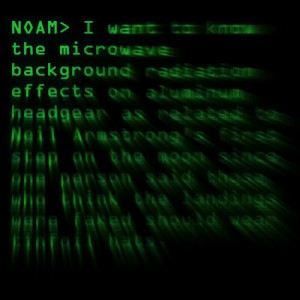An essay by Raymond C. Stewart, as provided by Damien Krsteski
Art by Dawn Vogel
Let me tell you a story about language.
In 2021, with the conclusion of the Human Brain Project, several months before fully publicizing the research finds, chunks of data were allocated randomly to four different institutions. Colleagues from Germany received slices of brain-data pertaining to aural signal analysis, professors from Scotland were allotted the tonotopical maps and the auditory cortex, University researchers from South Africa were granted the scanned neuroglia of the hypothalamus, and our University got the brain’s language processing algorithms.
That is when we created Noam, our experiment.
Noam’s purpose was to help us figure out our own brains by embodying a part of them. The mapped neurons were simulated on a cluster of supercomputers buried under our campus, and on our lab screens we saw a virtual representation of him sit in a corner of his gray room, absolutely motionless.
Minimalism was the core concept of our experiment. Giving him a complete set of functions (visual, auditory, motor) would serve us no purpose, but besides the language skills, he needed memory to commit facts to, so we gave him that.
Once Noam was set up, we needed to start communicating, but he was a grey blur, completely deaf-mute, and dumb as a brick.
We needed a way to connect his language processing algorithms to a knowledge-acquiring process.
I began work on the programming language for the task, tentatively called Noamian. I based it on Prolog, to a certain extent, but made it closer to plain English: likes(Robin, Noam) became “Robin likes Noam,” a fact he could commit to his memory and thus provide an affirmative answer to the query “Does Robin like Noam?”
His knowledge was limited to what we gave him, and the sliver of Internet access he was allowed was used for grammatical analysis. His answer to a factual question such as “Is it raining?” was not based on actual weather data, but on a yes/no boolean fact coded into his database.
With time, the complexity and versatility of Noamian grew. We were soon able to chain predicates, such as “Bobby likes Noam, but hates John, and loves apples.” By processing the code, Noam could understand the subject of the sentence is Bobby and then easily convert it to facts in the format: likes(Bobby, Noam), hates(Bobby, John), loves(Bobby, apples).
Programming languages group actions together into functions, and Noamian was no different. Encapsulated into an “About” block, the predicates would remain within the confines of the function, therefore the sentence “About Horses: they are big, they are fast, they are strong.” represents the Horse function. When queried “Are horses big?” Noam would answer in the affirmative. Likewise, the query “Tell me about horses” would return all known facts on the animal within his memory.
Functions could inherit facts from other functions, so the sentence “About Unicorns (They are like Horses): …” would allow the Unicorn models in Noam’s memory to share the same attributes as the already defined Horses.
It is worth noting here that since our end-goal required the isolation of language from other high-level brain functions like image recognition, we never allowed Noam to make the connection between a “Horse” and its visual representation. Instead, it remained just that–a word in his memory interlinked to other words.
With time, and many lines of Noamian written, his knowledge map grew. Obviously, it wasn’t our intention to manually grant Noam the entire fact set of all of human knowledge, so when his relational memory got sufficiently large, we moved to the next step.
To read the rest of this story, check out the Mad Scientist Journal: Winter 2014 collection.
Raymond C. Stewart is an artificial intelligence professor, specialized in the field of natural language processing. Happily married, he lives with his wife and two children in Boston, Massachusetts.
Damien Krsteski is an SF author from Skopje, Macedonia. His work has appeared in places like Liquid Imagination, Fiction Vortex, The Way of the Buffalo Podcast, Fiction365 and others. More information about his work can be found at http://monochromewish.blogspot.com
Dawn Vogel has been published as a short fiction author and an editor of both fiction and non-fiction. Although art is not her strongest suit, she’s happy to contribute occasional art to Mad Scientist Journal. By day, she edits reports for and manages an office of historians and archaeologists. In her alleged spare time, she runs a craft business and tries to find time for writing. She lives in Seattle with her awesome husband (and fellow author), Jeremy Zimmerman, and their herd of cats. For more of Dawn’s work visit http://historythatneverwas.com/
Follow us online:
